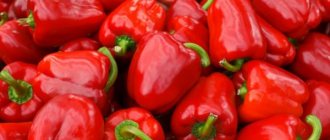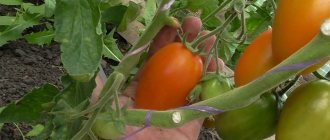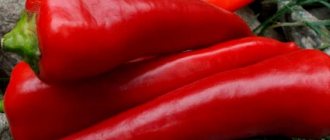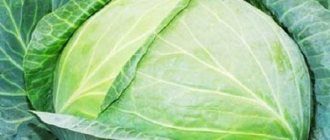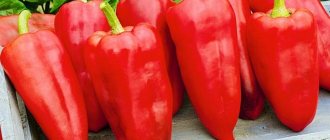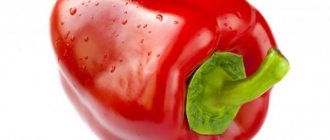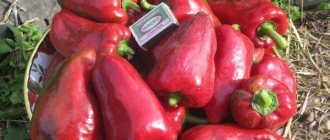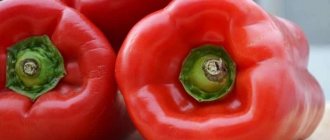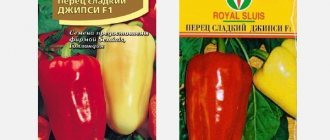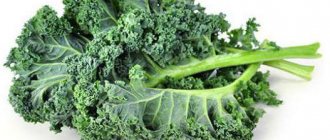Characteristics of the variety and description of the fruits
Agapovsky sweet pepper has been registered in the State Register of the Russian Federation since 1995. Belongs to early ripening varieties.
After the appearance of friendly shoots, the crop is ready to yield the harvest at technical ripeness on the 99-110th day.
The plant forms a central stem of medium height, up to 80 cm. The bushes are compact, but heavily leafy, protecting the peppers from exposure to sunlight. The cultivar amicably sets fruits with a drooping arrangement on the stems. Up to 25-30 full-sized peppercorns are formed on one bush.
In the stage of milky ripeness, the vegetables are dark green in color; as they ripen, they acquire a red color (see photo).
Peppers are cube-shaped with a thin skin but a fleshy wall: the thickness of the pericarp is 7-8 mm. The average weight of one fruit is 120 g, length is 10-12 cm.
In the description of the variety, the originator indicates that Agapovsky sweet pepper is endowed with a strong peppery aroma. This fact is confirmed by consumer reviews.
The cultivar is one of the most productive among the early ripening representatives of this nightshade crop. In protected ground conditions from 1 sq. m. you can expect up to 10 kg of yield.
The crop begins to bear fruit in July. The harvest is harvested until the end of September.
Due to its excellent taste, thickness and size of the fruit, Agapovsky has a universal purpose in cooking: it is used to make fresh salads, frozen, stuffed, prepared first and second courses, and canned.
What you need to know about Agapovsky pepper before growing
Sweet pepper subshrubs can be found in many areas of agricultural lovers. Agapovsky pepper is one of them. This variety was obtained by Russian breeders more than 2 decades ago and registered in the State Register. Over the years of its existence, this sweet bell pepper has spread throughout the Russian Federation.
Why are you interested?
The vegetable plant has an attractive appearance - on a powerful stem among the leaves there are many huge, fleshy, rich red fruits. Moreover, the peppers are the same in size as the hybrids, have a wonderful taste and many useful substances in their composition. And the smell of sweet bell pepper is firmly preserved even in processed fruits of the Agapovsky variety.
Description of the variety
Manufacturers give the following description of the variety:
| Information about the variety | The variety was obtained in Russia as a result of breeding work. |
| Pollination type | Although Agapovsky pepper is self-pollinating, you need to tap its peduncle once a day to speed up the process. |
| View | The bush is semi-determinate. |
| Type of ovary formation | According to the type of ovary formation, the vegetable plant belongs to the bouquet varieties. 3-4 fruits can grow nearby. |
| Maturation speed | The variety is early, 110–120 days should pass from sowing the seed material into the soil until the fruits appear at technical ripeness. |
| Growing area | It is grown indoors. Regions II and III light zones of Russia are considered the best for cultivation. |
| Planting density (planting pattern) | When planting seedlings on ridges, the density must be observed - 4 bushes per 1 m². If the plants are close to each other, then the size of ripe fruits decreases significantly. |
| Productivity | 9-10 kg of fruits per 1 m². |
| Fruit type | The fruits are prism-shaped, 9–11 cm long. In technical ripeness they are dark green in color, and in biological ripeness they are fiery. Sweet bell pepper of the Agapovsky variety has a pronounced aroma. |
| Purpose of fruits | The fruits are universal: they are used fresh for salads, for canning, preparing preparations for the winter and main courses. |
| Resistance to adverse conditions | Bushes require constant and abundant watering. With a regular lack of moisture and decreased light, fruits stop setting. |
| Disease resistance | The variety is resistant to fungal and viral diseases. But blossom end rot and tobacco mosaic can overcome it. Sweet bell peppers can also be attacked by aphids, whiteflies and spider mites. |
Appearance
The bush is low, compact, heavily leafy, less than 1 m high. The leaf blades are large, of a standard dark green color. The flowers are small and white. The tops of the peppers are directed towards the ground.
The fruits have an attractive appearance:
- Large ones - weighing about 110 g, and if all cultivation rules are followed, they grow up to 350 g.
- Thick-walled - the pulp reaches a thickness of 6 mm.
- With a smooth and slightly ribbed surface.
- The stalk is slightly pressed inward.
Vegetables also tolerate transportation well and are stored for a long time in the refrigerator or cellar at a temperature of +10°C.
Pros and cons of the variety
The Agapovsky variety has both advantages and disadvantages over other sweet bell peppers.
Many farmers highlight the following positive qualities:
- fairly rapid ripening;
- high productivity;
- resistance to attack by insect pests and most infections affecting nightshade crops;
- attractive appearance of the plant and its fruits;
- the versatility of using ripe peppers, their excellent taste;
- high content of useful microelements and nutrients in the pulp.
And the negative sides include:
- demands for high-quality watering and good lighting;
- there is a risk of contracting certain diseases.
Thus, the variety has many more advantages than disadvantages.
Features of cultivation
Experienced vegetable growers highlight the following features of growing Agapovsky peppers:
- grows and bears fruit better in protected soil;
- the bush requires support and garter;
- you need to remove the flower in the 1st branch of the main shoot - this will lead to an increase in green mass and have a positive effect on productivity;
- at the very end of July, you need to pinch all the stems and remove the buds and flowers, because they will no longer ripen, but will only take away the strength of the bush. This procedure should be carried out in mid-August.
And we must not forget to remove the fruits in time so that they do not slow down the process of the appearance of new ovaries.
Features of cultivation and care
The period of planting seeds for seedlings of the Agapovsky variety begins on February 20. When grown in open ground, sowing can be done 10 days later. The timing of planting work largely depends on the region.
By the time of planting in a permanent place, the gardener must take into account that the seedlings must reach the age of 60-70 days.
Transplantation into separate containers at home is carried out in the single-leaf phase. Picking pepper later will lead to severe stress in the seedlings.
Plants are planted in greenhouses and under film covers from mid to late May. Bushes are moved to open beds in the first ten days of June. Per sq. m. no more than 3-4 plants are placed.
In greenhouse conditions, Agapovsky is recommended to be grown on a trellis with the formation of two stems. On the bushes, remove all excess shoots and yellow leaves up to the first fork.
Like all varieties of peppers, Agapovsky loves timely, abundant watering with warm water and fertilizing. It is enough to apply fertilizers up to 2-3 times per season. Use organic or mineral complexes (can be alternated). The manufacturer recommends using “Zdraven-Aqua” and “Zdraven-Turbo”. To increase immunity, you can treat the leaf with Epin or its analogues.
The basis of care is also regular weeding and loosening of the soil for better aeration. The procedures can be replaced by mulching the soil with straw or a special agrofibre film.
Main pros and cons
When choosing pepper seeds, every gardener first of all pays attention to the positive and negative qualities of a particular variety. “Agapovo” peppers have practically no drawbacks, however, they require proper care and compliance with a number of rules during the cultivation period.
You may be interested in: Favorable days for picking pepper in 2021 according to the lunar calendar Favorable days for planting pepper for seedlings in 2021: terms and rules for sowing at home Favorable days for sowing sweet and bitter pepper for seedlings in 2021
pros
- good product characteristics;
- high level of productivity;
- low susceptibility to diseases and pests;
- excellent taste and pleasant aroma;
- the ability to use fruits in cooking when preparing a large number of dishes;
- compact size of ripe fruits.
Minuses:
- the need for good lighting, otherwise the bush may wither and the buds may fall off;
- strict adherence to watering times for the full development of plants.
Disease resistance of the variety
The Agapovsky sweet pepper variety is rarely susceptible to diseases typical of nightshades. If this happens, it is only due to the fault of the gardener who did not follow the rules of agricultural technology. The following preventive measures will help you avoid problems when growing:
- soil disinfection before planting;
- compliance with crop rotation (plant after nightshade);
- placement of plantings at a far distance from the cucumber;
- maintaining optimal humidity and temperature in greenhouses.
Advantages and disadvantages
According to reviews from gardeners, as well as from the characteristics and description of the originator, the Agapovsky variety has the following advantages:
- early entry into fruiting;
- suitable for growing in cold regions;
- resistant to temperature changes and nightshade diseases;
- brings a stable and rich harvest throughout the growing season;
- stands out for its excellent taste characteristics among early ripening varieties;
- Suitable for all types of culinary processing.
Among the disadvantages of the Agapovsky pepper variety, one can highlight the need to tie and form bushes in greenhouse cultivation conditions.
Comparison with similar varieties
Agapovsky pepper can be compared with the following cultivars that have proven themselves among gardeners:
- Red side is an early ripening pepper that forms fruits, ready for consumption, 100-105 days after germination. It is distinguished by its large fruit and thickness: the weight of one vegetable reaches 250 grams. Resistant to major nightshade diseases.
- California miracle belongs to the line of mid-early cultivars. The low-growing bush produces cube-shaped, thick-walled red fruits weighing up to 130 grams. The peculiarity of the cultivar is its high resistance to the tobacco mosaic virus.
- Early ripening pepper Red Riding Hood yields its harvest after the beginning of the growing season after 110-115 days. The originator is Aelita. The bush is semi-standard, 70-80 cm high. The fruits of this variety are somewhat larger than those of Agapovsky pepper: on average they gain weight of 200 g, the very first ones weigh up to 250 g. The plant tolerates light deficits and short-term cold snaps well. Productivity from an area of 1 sq. m. in greenhouse conditions reaches 10 kg.
- Viking is ideal for cultivation in northern regions due to its adaptation to harsh weather conditions. It bears fruit early. Red cylindrical fruits gain an average weight of 100 grams. The culture is classified as medium-sized.
- Big jackpot earlier than Agapovsky. Fruiting begins after the seedlings appear 80-90 days later. The plant forms a central shoot of medium height with a semi-spreading crown. The weight of the fruit reaches 300 grams. in the largest specimens. The yield when cultivated under covering structures is 6 kg per square meter. m.
Description of Agapovsky pepper
What could be tastier and healthier than juicy and tasty vegetables? They are simply irreplaceable, as they are a source of vitamins and minerals. Agapovsky pepper is a worthy representative of vegetable crops. In terms of vitamin C content, this vegetable crop surpasses even lemons and currants. What's special about Agapovsky pepper? How to grow it correctly? What care is needed to reap a good harvest?
Characteristics of the variety
Sweet pepper has a number of features associated with the origin of this garden crop. It grows best in warm places, which is why greenhouses are usually used for planting.
The characteristics indicate that Agapovsky sweet pepper belongs to the early ripening varieties. This is an annual garden vegetable crop. Its cultivation takes about 120 days (from planting to full maturity). It is characterized by good fruit yield (9.5-10.3 kg/sq. m).
The characteristics indicate that the variety is distinguished by its versatility in consumption (fresh, in various preserves).
Description of the fruit
The fruit is hollow, has a shape similar to a prism, and is large in size. The taste is fresh, sweetish. The fruits are juicy and have a pleasant characteristic aroma.
The surface of the pepper is smooth, slightly ribbed. When technical ripeness occurs, it becomes dark green, while at biological ripeness it becomes bright red. The fruits have a fairly large mass (about 120 g), and the wall thickness is up to 7 mm.
Description of the bush
Description of the bush: the plant has a compact size, medium height. This is a clear advantage for people who grow this crop on small plots of land, for example, in a house plot or a small vegetable garden.
There are quite a lot of leaves on the stem. They are dark green, large and wide. On the plant, the fruits are located drooping.
Growing
Peppers need to be sprayed
The description says that at the time of transplantation, the seedlings should be 95-100 days old. It is best to immediately plant the seeds in single peat pots, as the crop does not tolerate diving well.
- Before planting, the seeds should be allowed to soak in warm water.
- Then they are planted in small peat pots and covered with plastic film or glass.
- Do not forget about the temperature regime - at least 20 ºС during the day, 15 ºС at night.
- Lighting does not play a big role in the initial stages.
- Water the seedlings with warm water and make sure that the soil does not dry out.
It is worth planting in open ground in May-June, and in a greenhouse in April. Remember not to expose the roots! It is recommended to plant additional tall crops (tomatoes, corn) between the pepper beds, as they are susceptible to cross-pollination.
Cultivation care
The principle of caring for pepper, like most similar garden crops, is timely watering, fertilizing, gartering and other procedures aimed at improving the yield and quality of the fruit.
You have the power to attract insects to your garden. The crop needs pollination. You need to spray the plants with a solution of sugar in water.
Fertilizing is done with chicken manure no more than four times per crop growing season, mineral fertilizers or nettle infusion.
Possible diseases
Most often, sweet peppers are affected by diseases such as white rot, blossom end rot, and black leg. To prevent them, you need to carefully monitor the volume of watering.
The crop is susceptible to pests: slugs, aphids, whiteflies, and Colorado potato beetles. They fight insects not only with traditional methods, but also with the help of chemicals.
The characteristics indicate that the Agapovsky variety is resistant to the tobacco mosaic virus.
